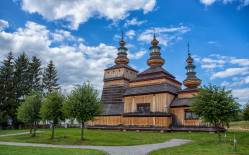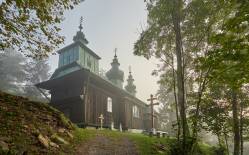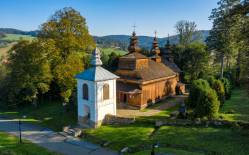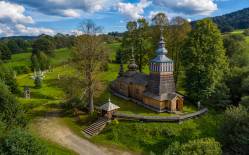Tserkva of Sts. Cosmas and Damian in Kotań ranks among the most beautiful examples of wooden architecture preserved in the western and central Lemkovyna. The Orthodox parish was established here in the late 16th/early 17th century and a tserkva most probably was built here at the same time (the oldest bell dates from 1629).
The present tserkva was built in the 1700s. In 1927 most inhabitants of the village reconverted into Orthodox Christianity as a result of which the tserkva was not used as frequently. After the Lemko population was forcefully relocated from the area in the 1940s, there was no one left to take care of the building.
The tripartite log church, oriented eastward, represents the north-western Lemko style of construction. All the three parts of the tserkva are covered with multi-tiered four-pitched roofs topped with neo-Baroque turrets.
On the western side there is a bell-tower comprising the narthex and annex structures. It is a post-and-frame construction.
In 1963 the building was thoroughly refurbished whereby the damaged parts of the structure and the shingle covering were restored. In 1962 the furnishings, including the iconostasis from 1689, were moved to the Icon Repository in Łańcut. Shortly after words, the building was acquired by Roman Catholics. In 2010 part of the iconostasis, comprising 16 icons, was returned.
A replica of this tserkva was built in the open-air museum in Lviv, as a model example of sacral architecture typical of Lemkovyna.
The adjacent cemetery is surrounded with a stone wall, over which a shingled roof was superimposed in 1963. Along the wall there is a wooden post-and-beam gate. An exposition of Lemko-style sepulchral art as well as roadside shrines and figures was arranged within the cemetery next to the tserkva in the 1960s.
Photos: Krystian Kłysewicz, Michał Wójtowicz
Gallery
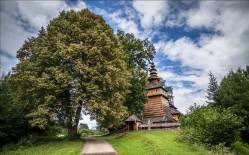
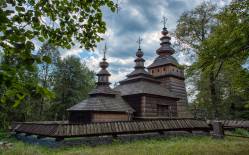
Recommended venues on the Trail



This website has been modernized with the financial support of the European Union under the Cross-Border Cooperation Programme Poland-Belarus-Ukraine 2014-2020. The responsibility for its content lies solely with the Podkarpackie Regional Tourism Board and cannot, in any case, be treated as a reflection of the position of the European Union, the Managing Authority, or the Joint Technical Secretariat of the Cross-Border Cooperation Programme Poland-Belarus-Ukraine 2014-2020.










